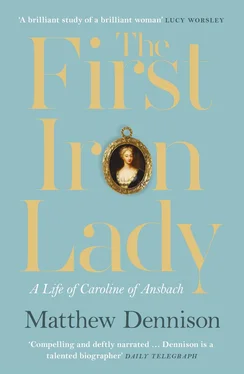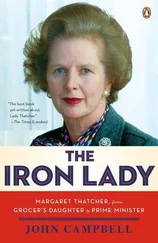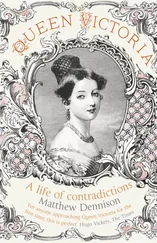No royal guards attended prince and princess in their hasty flit. The doors of the palace were closed against them, the Chapel Royal too, their attendance at court forbidden and every special act of deference suspended. Still the choleric and implacable monarch protested at his inability under British law to halt their payments from the civil list. Even Caroline’s children, a baby of three weeks and three daughters ranging in age from four to eight, were prevented from accompanying her in this hour of disgrace. They remained abed within the palace. The king had ‘[taken] his grey goose quill/And dip’t it o’er in gall’, a balladeer wrote. His sentence was comprehensive:
Take hence yourself, and eke your spouse,
Your maidens and your men,
Your trunks, and all your trumpery,
Except your children. 9
Where the royal couple took their unhappy caravanserai was the house of Henry d’Auverquerque, Earl of Grantham. Since February, this slow-witted loyalist, his character dominated by ‘gluttony and idleness, … a good stomach and a bad head, … stupidity and ennui’, had served as Caroline’s lord chamberlain, the highest-ranking officer of her household. 10
Up St James’s Street the convoy jolted. Across Piccadilly to Grantham House in Dover Street it wound its way. Servants followed separately, in the glimmering illumination of the new round glass street lamps, lit only on moonless nights, that marvelling visitors to the city likened to ‘little Suns of the Night ’. 11The Duke of Portland described the party on arrival as ‘in the utmost grief and disorder, the Prince cried for two hours, and the Princess swooned several times’. 12Caroline had given birth only weeks earlier, an event, in the words of one phlegmatic diarist, ‘which occasioned great joy for the present, but proved of short duration’. 13Following months of escalating tension, the baby’s christening was the battleground on which king and prince collided. By 2 December neither Caroline’s strength nor her nerves had recovered from birth or baptism. Besides the daughters she entrusted to governesses on that darkest evening, she left behind her in the care of his wetnurse her baby son.
Caroline’s friend, the Countess of Bückeburg, recalled the anguish of their parting: ‘The poor Princess went into one faint after another when her weeping little Princesses said goodbye.’ 14Caroline had told the king that she valued her children ‘not as a grain of sand compared to [her husband]’, but there was more of bravado than truth in the statement. 15None of the family would recover from the fissure wrought that winter night. Before the spring was out, the baby Caroline left behind her ‘kick’d up his heels and died’. 16He was killed by ‘convulsions’, water on the brain, a cyst on his tiny heart; each internal organ was swollen, distended, angrily inflamed. The miracle was that he had survived so long. 17That this looked bad for the king was cold comfort for a grief-stricken Caroline. ‘That which, in our more liberal age, would be considered as bare invective and scurrility, was the popular language of those times,’ wrote Lord Hailes, looking back in 1788. 18In this instance scurrility rose up in Caroline’s defence. Doggerel commended her suffering; it condemned the king’s heartlessness: ‘Let Baby cry/Or Lit [sic] it die/Own Mother’s Milk deny’d,/He no more car’d/How poor thing far’d.’ 19
‘Over the Hills and Far Away’ sang beautiful Mary Bellenden, and rain and darkness engulfed her song. The king she meant to upbraid was not listening, and the royal gaggle’s short journey, undertaken pell-mell on foot in view of a hastily convened sympathetic crowd, soon carried them out of earshot. In Lord Grantham’s house, smaller than their apartments in St James’s Palace, prince and princess were forced to share a bedroom. Such intimacy, and confines of space, prevented any ceremonial in their rising or retiring to bed, the complex rigmarole of bedchamber staff, of basins and ewers proffered on bended knee, shifts, chemises, gloves, fans and shoes presented or withdrawn by attendants greedy for the privilege: the ritualised posturing of baroque monarchy. Instead ‘Higgledy-piggledy they lay/And all went rantam scantam.’ 20
To his father, the prince dispatched the tersest of notes. ‘I have just obeyed your Majesty’s orders, having left St James’s. The Princess goes along with me, and our Servants shall follow with all imaginable Expedition.’ 21No response was requested or forthcoming.
‘I am so sorry for our dear Princess of Wales that I shed tears for her yesterday,’ her closest correspondent wrote. 22As a measure of his distress, George Augustus succumbed to a feverish ‘inflammatory distemper, with bumps in his face somewhat like a rash’. Doctors treated Caroline for fainting fits and violent throat pains. 23For all its brevity, her journey from familiar certainties, beginning with a walk in the dark, was a big one. Her life encompasses its share of new beginnings and abrupt severances.
PART ONE
Germany
I
‘Bred up in the softness of a Court’
In Wenceslaus Hollar, the old palace of Ansbach – towered, turreted and architecturally uninspiring – found its ideal chronographer. An etcher from Bohemia, born in 1607 and destined, surely unfairly, to die in poverty, Hollar worked in black and white for a fixed rate of fourpence an hour, creating topographical views as intricately wrought as Flemish lace.
First printed in the 1630s, Hollar’s view of the south German town of Ansbach has a congested spikiness. He delighted in inky shadows, details sharp as pinpricks, the awkward geometry of serried roofs. The tiny figures he scattered across his panorama – riding in a coach, chasing a stag across an empty field – are fragile as house spiders and likewise insignificant. Like spiders they thread the crooked streets. Their meagre limbs are gossamer alongside the solider outlines of steeples and town walls and the criss-cross fronts of timber-framed merchants’ houses. Hidden from view are Ansbach’s metalworkers and cloth-makers, whose workshops oozed woodsmoke and sweat. Out of earshot the ring of hammers and wooden tools, expletives, invective, laughter.
Instead, it is the old Renaissance palace that draws the eye in Hollar’s etching. Built in the third quarter of the sixteenth century by an architect from Swabia called Blasius Berwart, it is a tall building of four storeys, and its walls form the sides of a square. Hollar depicts it as a cat’s cradle of uprights and mullioned windows. From its corners, narrow towers rise, topped by spires. Gables frame shuttered dormers. A pennant – or possibly a weathervane – flutters stiffly from the spire of the largest, central, hexagonal tower. Above the steep-pitched roof, a chimneystack supports a bird’s nest complete with resident stork. Hollar’s scale is all wrong, and the stork, brought to life, would have been enormous, like an airborne dodo. At the start of our chronicle the bird is appropriate, associated with new beginnings, harbinger of new life.
In one version of Hollar’s etching the building is labelled ‘ Furstlich Residents ’, ‘princely seat’, in letters as big as the palace windows. 1The same print offers the viewer a key: the princely seat is sight ‘A’. Hollar’s contemporaries would have agreed with him that any viewer’s primary interest must be the home of Ansbach’s first family – not the taller Gothic churches of St Gumbertus and St John to the east, nor the palace’s formal garden within crenelated walls to the west, each flowerbed a filigree square. Buildings close to the palace are nondescript by comparison: regular as boxes, like the plastic houses on a Monopoly board, much as they remain.
Читать дальше












